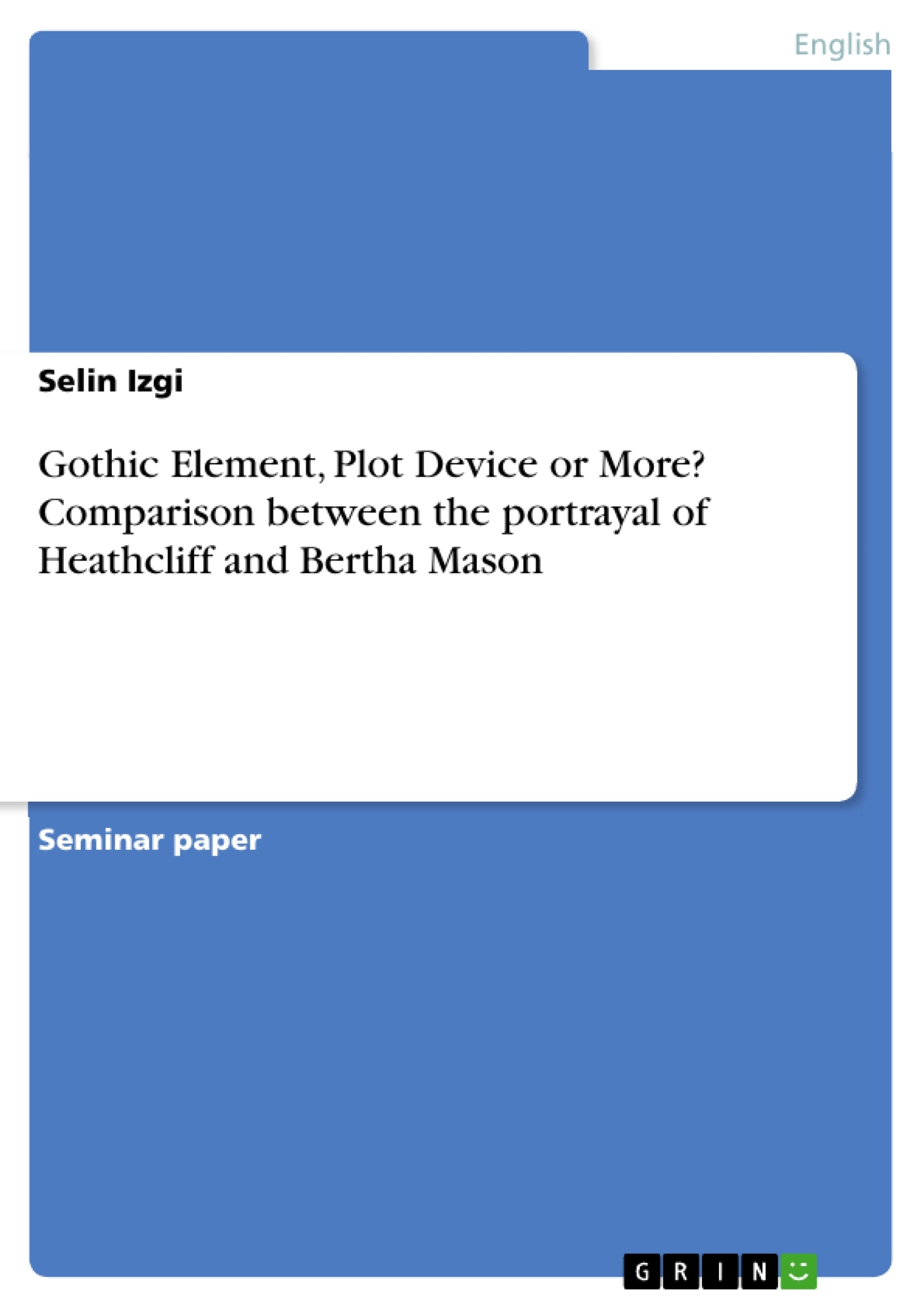In this research paper the author wants to take a closer look at the similarities and differences between Heathcliff and Bertha. While doing so she also wants to find out if their respective creators portrayed them just as a Gothic element, a stereotype, plot device or similar things or if their portrayal has a different kind of thought behind it. While reading Jane Eyre and letters Charlotte Bronte send regarding Wuthering Heights she noticed an almost extreme opinion Charlotte seems to have about people of colour. The interest for this topic comes from the fact that there is a lot of research about the Otherness of both characters but rarely are they compared with each other. Oftentimes Charlotte and her opinions about her sisters novel Wuthering Heights are quoted in research but rarely does anyone comment on her extreme view on Heathcliff. Her critique of Wuthering Heights is mostly only analysed in regard to her sister. So, with this paper the author also wants to take a closer look at the things Charlotte Bronte had to say about Heathcliff and about how she herself portrayed the Other in her novel, Jane Eyre.
She will also take a quick look at Jean Rhys’ Wide Sargasso Sea in order to be able to differentiate the way Charlotte, who had lived her whole life in England, and Jean Rhys, who had been living on a Caribbean island, similar to Bertha, portray the same character. This could show whether or not Charlotte had, as the author presumes, a more racist view on the post-colonial regions and people than her sister Emily.
Inhaltsverzeichnis (Table of Contents)
- Introduction
- Heathcliff
- Heathcliff's origin
- Heathcliff as a terrorist at Wuthering Heights
- The Brontë's view of Heathcliff
- Bertha Mason
- The Mad Woman in the Attic - Bertha as Jane's Dark Double?
- Bertha in Wide Sargasso Sea
- Comparison between Heathcliff and Bertha
- The Other and Gothic
- Conclusion
Zielsetzung und Themenschwerpunkte (Objectives and Key Themes)
This research paper explores the similarities and differences between the characters of Heathcliff and Bertha Mason, both of whom are presented as Gothic elements in their respective novels, Wuthering Heights and Jane Eyre. The paper examines whether their portrayal is solely a result of Gothic conventions or reflects deeper thematic concerns. It further investigates Charlotte Brontë's views on people of color, particularly in relation to Heathcliff, and contrasts her portrayal of the Other in Jane Eyre with Jean Rhys's interpretation of Bertha in Wide Sargasso Sea.
- The representation of the Other in 19th-century Gothic literature
- The portrayal of Heathcliff and Bertha Mason as Gothic elements and their connection to racial stereotypes
- Charlotte Brontë's perspective on people of color and the post-colonial context
- The impact of societal and cultural influences on character development
- The interplay of domestic and Gothic spaces in both novels
Zusammenfassung der Kapitel (Chapter Summaries)
- Introduction: This chapter introduces the context of the research paper, highlighting the significance of Heathcliff and Bertha Mason as complex characters in the Brontë sisters' works. It emphasizes the need to analyze their portrayal beyond the framework of Gothic elements, exploring possible deeper implications and societal influences.
- Heathcliff: This chapter delves into the character of Heathcliff, exploring his mysterious origins, his role as a dominant figure at Wuthering Heights, and his impact on the lives of those around him. The chapter examines how his treatment by Hindley and others contributes to his destructive behavior, questioning whether he is truly a savage or a victim of circumstances.
- Heathcliff's origin: This section focuses on Heathcliff's early life and his arrival at Wuthering Heights, suggesting his possible origins in the slave trade. It explores the prejudices he faces from the Earnshaw family and their staff, highlighting the role of race in shaping his experiences.
- Heathcliff as a terrorist at Wuthering Heights: This section analyzes Heathcliff's role as a dominating figure at Wuthering Heights, investigating his use of domestic and legal means to exert control and seek revenge against those who mistreated him. It examines the blurring of domestic and Gothic spaces in the narrative and suggests that Heathcliff is not entirely different from those he seeks to torment.
- The Brontë's view of Heathcliff: This section explores Charlotte Brontë's perspective on Heathcliff, highlighting her use of racist language and her perception of him as a demon. It considers Emily Brontë's portrayal of Heathcliff in Wuthering Heights and the ways in which she might have challenged her sister's views.
Schlüsselwörter (Keywords)
Key terms and concepts explored in this research paper include Gothic literature, the Other, racial stereotypes, post-colonialism, domestic space, violence, revenge, love, and the Brontë sisters. The paper focuses on the characters of Heathcliff and Bertha Mason, examining their portrayal within the context of societal and cultural influences of the 19th century.
- Quote paper
- Selin Izgi (Author), 2018, Gothic Element, Plot Device or More? Comparison between the portrayal of Heathcliff and Bertha Mason, Munich, GRIN Verlag, https://www.grin.com/document/1005655



